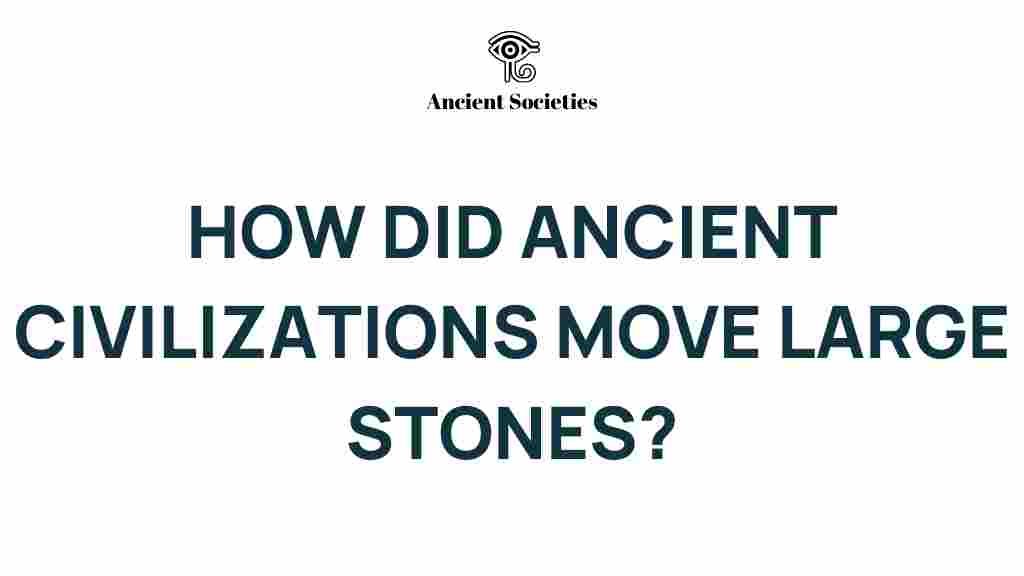Unraveling the Mystery: How Ancient Civilizations Transported Massive Stones
The impressive architectural wonders of ancient civilizations have long captivated historians, archaeologists, and the general public alike. From the colossal stones of Stonehenge to the towering pyramids of Giza, the ability of these early societies to transport massive stones remains an enduring mystery. In this article, we will delve into the ingenious engineering feats, historical methods, and construction techniques that enabled ancient civilizations to move these monumental stones. We will explore the various theories and archaeological findings that shed light on these remarkable capabilities.
The Importance of Stone Transportation in Ancient Civilizations
Transportation of stone was crucial for various reasons:
- Monumental Architecture: Many ancient civilizations aimed to create lasting monuments that showcased their power, beliefs, and artistic achievements.
- Religious Significance: Large stones often served as altars or markers for significant spiritual sites, which required careful positioning.
- Trade and Economy: Transporting stone not only allowed for construction but also facilitated trade routes, enhancing economic growth.
Engineering Feats of Ancient Civilizations
Ancient civilizations were remarkable in their engineering capabilities. The methods they employed to move massive stones are still celebrated for their ingenuity. Let’s explore some of the historical methods used by these cultures.
1. The Use of Rollers and Sledges
One of the oldest methods of stone transportation involved the use of wooden rollers and sledges. This technique was utilized by the Egyptians and other ancient cultures:
- Rollers: Logs were placed under heavy stones, allowing teams of workers to push or pull the stones over the ground.
- Sledges: Flat-bottomed sledges were designed to carry stones. Workers would pull these sledges over a prepared surface, often lubricated with water or oil to reduce friction.
2. Lever Systems
Lever systems were another ingenious solution. Ancient engineers used levers to lift and maneuver heavy stones:
- Fulcrum Points: A strong beam was placed on a fulcrum, allowing workers to lift one end of the stone and move it.
- Teamwork: Many workers were required to pull on ropes attached to the stone, utilizing the lever’s mechanical advantage.
3. Water Transportation
In some regions, ancient civilizations took advantage of waterways:
- Barges: Stones were loaded onto large wooden barges and floated down rivers to construction sites.
- Canals: Man-made canals facilitated the movement of heavy stones over long distances.
Historical Methods and Techniques in Different Civilizations
Various ancient civilizations developed unique methods tailored to their environments and resources:
A. The Egyptians
The Egyptians are perhaps the best known for their monumental architecture, including the Great Pyramids. Their techniques included:
- Cutting and Shaping Stones: Workers quarried stones from nearby sites and shaped them using copper tools.
- Transporting with Sledges: They used sledges, often lubricated with water, to drag massive stones across the desert sands.
B. The Incas
The Incas, known for their advanced engineering in the Andes, transported stones for their architectural marvels like Machu Picchu:
- Terracing: They built terraced roads to facilitate movement of stones up steep mountains.
- Manpower: Large teams of laborers worked together, using ropes and manpower to maneuver the stones.
C. The Mesopotamians
In ancient Mesopotamia, stone transportation techniques were equally advanced:
- Canal Systems: They developed extensive canal systems to transport stones by water.
- Brick Making: In some cases, they created mud bricks instead of using stone, which were easier to transport.
Archaeological Insights into Ancient Transportation Methods
Archaeological discoveries provide critical insights into how ancient civilizations achieved these engineering feats:
- Quarries: Excavations of ancient quarries reveal tools and remnants of construction techniques.
- Transport Routes: Studies of ancient roads and waterways illustrate how stones were moved efficiently.
- Artistic Depictions: Artifacts and carvings often depict the transportation of stones, showcasing the methods used.
Troubleshooting Tips for Understanding Ancient Techniques
As we explore the historical methods of stone transportation, it’s important to consider the challenges ancient civilizations faced:
- Terrain Challenges: Uneven or rocky terrain posed significant difficulties. Understanding local geography is essential.
- Resource Limitations: The availability of materials for tools and transportation systems affected efficiency.
- Labor Force: The size and organization of the workforce were critical in executing large-scale projects.
By examining these factors, we can better understand how ancient civilizations overcame obstacles to achieve their monumental architecture.
Modern Perspectives on Ancient Technology
Today, researchers and engineers study these ancient techniques to inspire modern construction methods:
- Innovative Materials: Learning from the past can inform the use of modern materials that mimic ancient stone’s properties.
- Project Management: Ancient methods emphasize the importance of teamwork and organization in large projects.
As we continue to unravel the mysteries of ancient stone transportation, it’s clear that the ingenuity of these civilizations laid the groundwork for modern engineering and construction techniques.
Conclusion
In conclusion, the stone transportation methods employed by ancient civilizations reflect a remarkable blend of ingenuity, engineering feats, and historical knowledge. From the Egyptians to the Incas and Mesopotamians, each civilization exhibited unique adaptations to their environments, allowing them to construct monumental architecture that has stood the test of time. The study of these historical methods offers invaluable insights into ancient technology and continues to inspire modern engineering practices.
As we delve deeper into archaeology and uncover more about these ancient societies, we gain a greater appreciation for the incredible achievements of our ancestors. To explore more about the fascinating world of ancient civilizations and their engineering marvels, visit this link. For detailed archaeological insights, check out this source.
This article is in the category Archaeology and created by AncientSocieties Team
